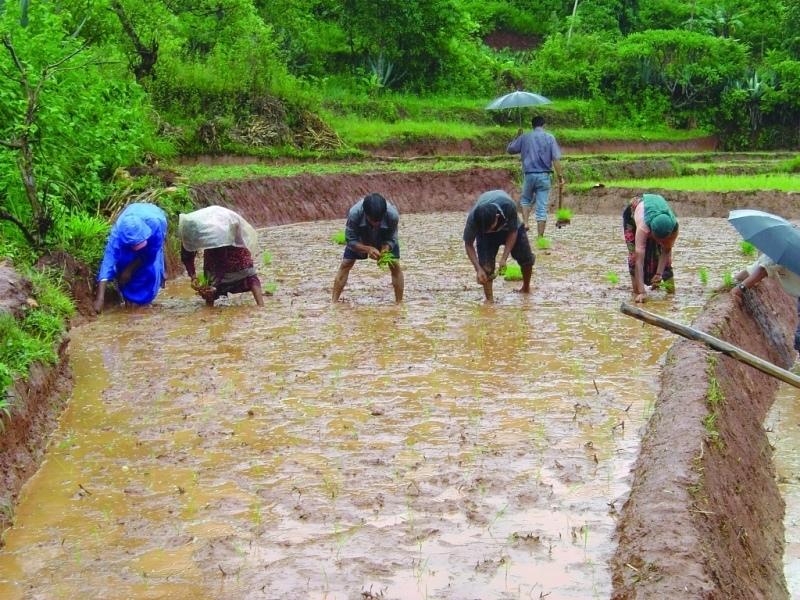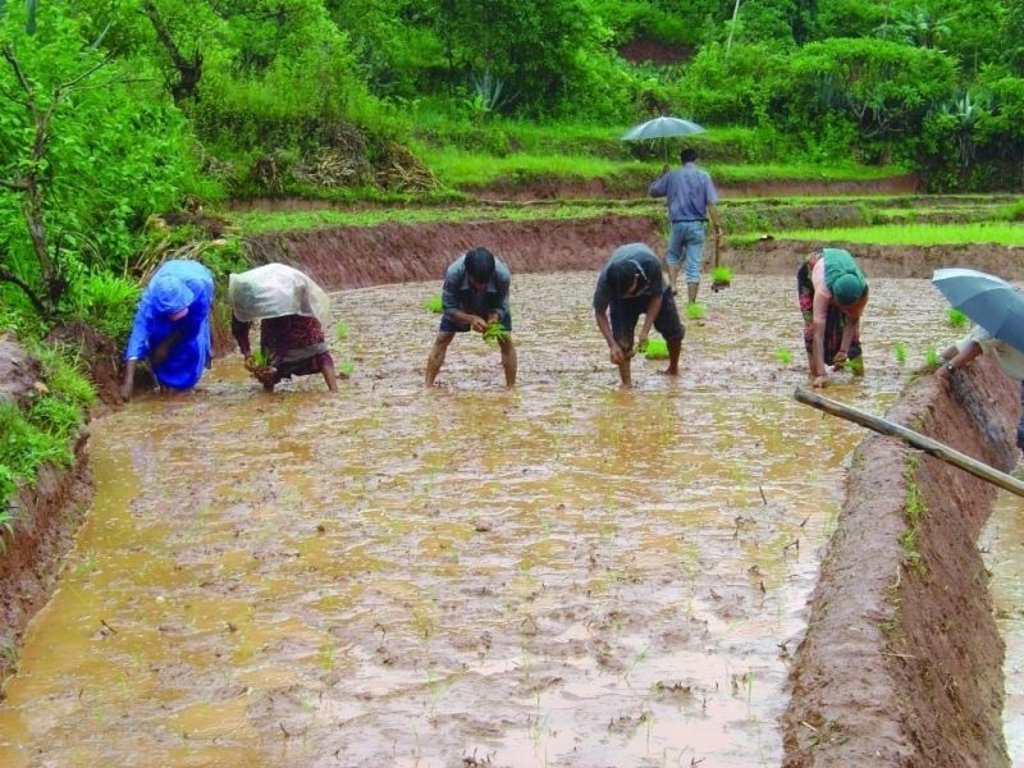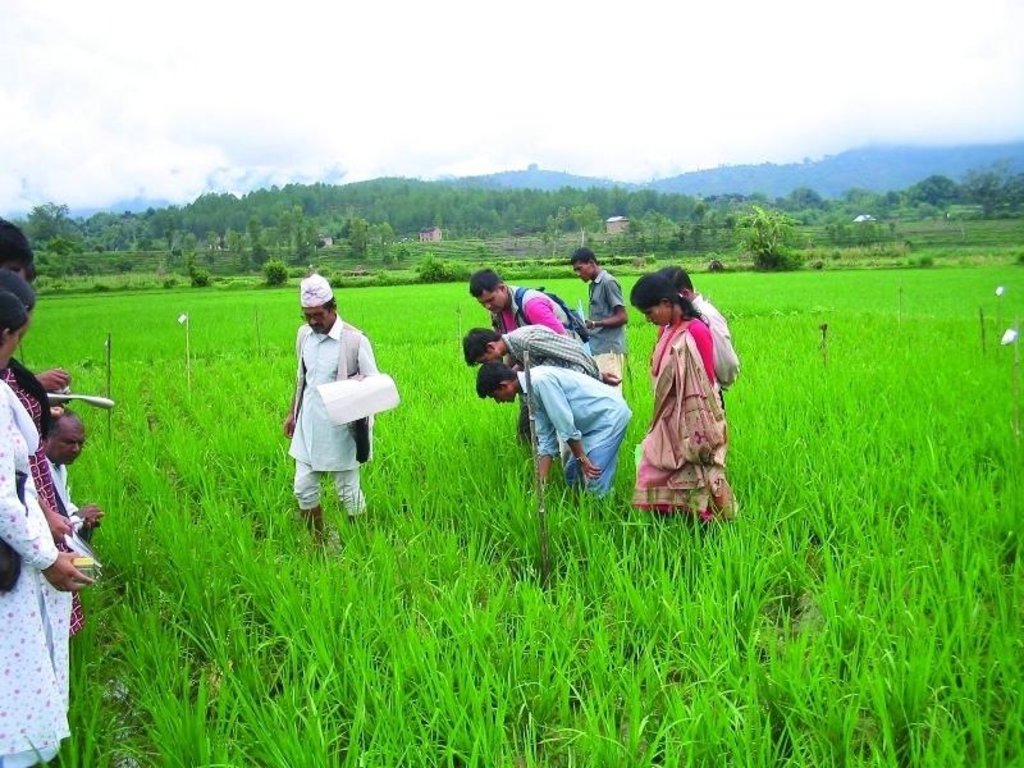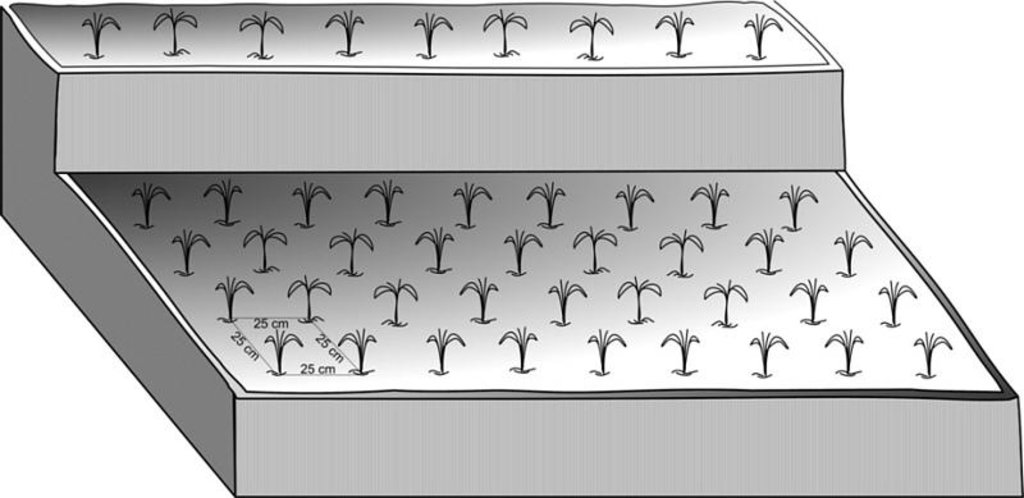System of Rice Intensification [Непал]
- Создание:
- Обновить:
- Составитель: Madhav Dhakal
- Редактор: –
- Рецензенты: David Streiff, Alexandra Gavilano
Dhan uttapadan bridi garne tarika - Nepali
technologies_1494 - Непал
Просмотреть разделы
Развернуть все Свернуть все1. Общая информация
1.2 Контактные данные специалистов и организаций, участвующих в описании и оценке Технологии
Специалист по УЗП:
Специалист по УЗП:
Специалист по УЗП:
Название организации (-ий), содействовавших документированию/оценке Технологии (если применимо)
ICIMOD International Centre for Integrated Mountain Development (ICIMOD) - Непал1.3 Условия, регламентирующие использование данных, собранных ВОКАТ
Составитель и ответственный(-ые) специалист(-ы) согласны с условиями, регламентирующими использование собранных ВОКАТ данных:
Да
1.5 Ссылка на Анкету (ы) по Подходам УЗП (документируется с использованием ВОКАТ)
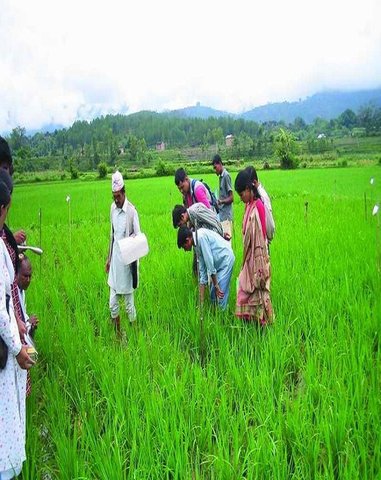
Evaluation of the System of Rice Intensification through … [Непал]
Conducting participatory action research with farmers and district level line agencies for demonstrating, disseminating and scaling up SRI
- Составитель: Madhav Dhakal
2. Описание Технологии УЗП
2.1 Краткое описание Технологии
Определение Технологии:
A method for increasing the productivity of rice by changing the management of plants, soil, water, and nutrients.
2.2 Подробное описание Технологии
Описание:
The System of Rice Intensification (SRI) was developed in Madagascar by Henri de Laulanie, in the 1980s. He worked with Malagasy farmers and colleagues to improve the possibilities of rice production. The practice contributes to both healthier soil and healthier plants, supported by greater root growth and the nurturing of soil microbial abundance and diversity. It is based on a number of well-founded agro-ecological principles. SRI concepts and practices have also been successfully adapted to upland rice.
SRI involves transplanting very young rice seedlings (usually 8-12 days old with just two small leaves) carefully and quickly so as to cause minimum disturbance to the roots. The seedlings are planted individually, in contrast to the traditional method where clumps of 3-4 are planted together, minimising root competition between the seedlings. The seedlings are kept widely spaced to allow better root and canopy growth, in a square grid pattern at a spacing of at least 25 x 25 cm. Planting can be done even wider at 30 x 30 or 40 x 40 cm and even up to 50 x 50 cm in the best quality soils.
The soil is kept moist but well drained and aerated to support increased biological activity. A small quantity of water is applied during the vegetative growth period following which a thin layer of water is maintained on the fields only during the flowering and grain-filling stages. Better quality compost, such as well decomposed farmyard manure, can be applied to achieve additional yield increases. Since weed growth will be more abundant and will be a problem in fields that are not kept flooded (and because of the wider spacing), weeding needs to be done at least once or twice in the first 10-12 days and a total of three or four times altogether before the canopy closes.
SRI does not require additional inputs like new seeds, chemical fertiliser or pesticides, but it does require the skilful management of the factors in production and, at least initially, 25-50% more labour inputs, particularly for the transplanting and weeding. As farmers become more skilled and confident in SRI, the amount of labour needed decreases and can eventually become the same or even less than with conventional methods.
SRI is being tried out by farmers in many areas of Nepal’s middle mountains including in the Jhikhu Khola watershed. This area has an altitude of 800-2200 masl, and receives about 1200 mm annual rainfall, about 70-80% in the monsoon months (June to September).
2.3 Фотографии, иллюстрирующие Технологию
2.5 Страна/ регион/ места, где применяется Технология, информация о которых собрана в данной Анкете
Страна:
Непал
Более точная привязка места:
Kavre palanchowk/Jhikhu Khola watershed
Охарактеризуйте пространственное распространение Технологии :
- равномерно-однородное применение на определенной площади
Если точная область неизвестна, укажите приблизительную площадь:
- < 0,1 км2 (10 га)
Пояснения:
This was the first year of on farm research cum demonstration on the farmers field after the trial in the research station. Six farmers tested SRI in 2003. It was tested in Panchkhal, Hokse, Bhimsensthan, Baluwa, and Patalekhet VDCs.
Map
×2.6 Сколько лет применяется данная Технология
Если год начала применения Технологии достоверно неизвестен, дайте примерную оценку:
- менее 10 лет назад (недавняя)
2.7 Внедрение Технологии
Укажите, как именно Технология УЗП была внедрена:
- через проекты/ внешнее вмешательство
Пояснения (тип проекта и т.д.):
Madagascar
3. Классификация Технологии УЗП
3.1 Основные цели и задачи реализации Технологии
- повышение производства
3.2 Текущий(-ие) тип(-ы) землепользования на территории, где применяется Технология

Пахотные угодья и плантации
- Однолетние культуры
Ежегодный урожай - Уточните культуры:
- зерновые культуры - кукуруза
- овощи - другие
- rice, wheat
Число урожаев за год:
- 3
Поясните:
Longest growing period in days: 150; Longest growing period from month to month: Jun - Oct; Second longest growing period in days: 120; Second longest growing period from month to month: Nov - Feb
Пояснения:
major cash crop: Vegetables
major food crop: Rice
other: Maize, wheat
Major land use problems (compiler’s opinion): Limited production due to soil fertility decline, increased amount of agrochemical inputs and lack of sufficient irrigation water and irrigation infrastructures.
Major land use problems (land users’ perception): Decreased production, lack of irrigation facilities and increased amount of chemical fertilizers.
3.4 Водоснабжение
Обеспеченность водой участков, где реализуется Технология :
- сочетание богарных и орошаемых земель
3.5 Категория УЗП, к которой относится Технология
- мероприятия по хранению и реализации продукции после уборки урожая
3.6 Мероприятия УЗП, выполняемые в рамках Технологии

управленческие мероприятия
- У2: Изменение формы/ интенсивности хозяйствования
3.7 Основные проблемы деградации земель, на решение которых направлена Технология

ухудшение химических свойств почв
- Хп: Снижение плодородия и уменьшение содержания органического вещества (вызванное не эрозией, а другими причинами)
Пояснения:
Main causes of degradation: urbanisation and infrastructure development (poor irrigation infrastructures), other natural causes (avalanches, volcanic eruptions, mud flows, highly susceptible natural resources, extreme topography, etc.) specify (uneven distribution of precipitation throughout the year), land tenure (population growth, separating famility members from a household.), labour availability (out migration for a off-farm employment)
Secondary causes of degradation: other human induced causes (specify) (Weak institutional collaboration), poverty / wealth (lack of government subsidy on agricultural sector), education, access to knowledge and support services (lack of sufficient discussion with concerned technicians and experienced farmers.)
3.8 Предотвращение и снижение деградации земель, или восстановление нарушенных земель
Укажите цель Технологии по отношению к деградации земель :
- снижение деградации земель
4. Технические характеристики, мероприятия по практической реализации, вложения и стоимость
4.1 Технический рисунок, иллюстрирующий Технологию
Спецификация (пояснения к техническому рисунку):
In the SRI method young seedlings (8-12 days old) are planted singly at a wide spacing of 25 x 25 cm or more
Technical knowledge required for field staff / advisors: moderate
Technical knowledge required for land users: low
Main technical functions: improved plant management, improved soil management, improved water management
Secondary technical functions: increase in organic matter, increase in soil fertility
Change of land use practices / intensity level: Planting method, irrigation method and soil fertility management is carriedout differently compare to traditional method.
Автор:
Madhav Dhakal , A. K. Thaku
4.2 Общая информация по необходимым вложениям и стоимости
Уточните, как рассчитывались затраты и вложения:
- на площадь, где применяется Технология
Укажите размер и единицу площади:
1 ha
Укажите денежные единицы, использованные для подсчета затрат:
- Доллары США
Укажите среднюю дневную заработную плату наемных работников:
2.10
4.4 Вложения и затраты, необходимые для начала реализации
Пояснения:
Duration of establishment phase: 0 month(s)
4.5 Поддержание/ текущее обслуживание
| Деятельность | Сроки/ повторяемость проведения | |
|---|---|---|
| 1. | Application of fertilizer | |
| 2. | Application of pesticides ( if required) | |
| 3. | Transplantation | monsoon, 8 to 12 days after seed sowing / |
| 4. | Irrigation of the mainfield ( to keep fields alternately dry and moist) | vegetative period / weekly after transplantation; |
| 5. | Weeding | vegetative period / 3-4 times; first within 10 day |
| 6. | Harvesting | October/November / |
| 7. | Nursery bed preparation, seed treatment and sowing | Beginning of monsoon / |
| 8. | Main field preparation ( ploughing and leveling) | Beginning of monsoon / |
4.6 Стоимость поддержания/ текущего обслуживания ( в год)
| Опишите затраты | Единица | Количество | Затраты на единицу | Общая стоимость на единицу | % затрат, оплаченных землепользователями | |
|---|---|---|---|---|---|---|
| Оплата труда | Maintaining field | Persons/day | 353,0 | 2,1 | 741,3 | 100,0 |
| Оборудование | Machin use | ha | 1,0 | 136,0 | 136,0 | 100,0 |
| Посадочный материал | Seeds | ha | 1,0 | 4,0 | 4,0 | 100,0 |
| Удобрения и ядохимикаты | Fertilizer | ha | 1,0 | 94,0 | 94,0 | 100,0 |
| Удобрения и ядохимикаты | Biocoides | ha | 1,0 | 56,0 | 56,0 | 100,0 |
| Общая стоимость поддержания Технологии | 1031,3 | |||||
| Общие затраты на поддержание Технологии в долларах США | 1031,3 | |||||
Пояснения:
labour: person -day, cost of agrochemicals
All costs were estimated in 2006.
4.7 Наиболее значимые факторы, влияющие на стоимость затрат
Опишите наиболее значимые факторы, влияющие на стоимость затрат:
Due to increased off-farm employment trend , there is lack of manpower for field operation, which increases the labour cost .
5. Природные и социально-экономические условия
5.1 Климат
Среднегодовое количество осадков
- < 250 мм
- 251-500 мм
- 501-750 мм
- 751-1000 мм
- 1001-1500 мм
- 1501-2000 мм
- 2001-3000 мм
- 3001-4000 мм
- > 4000 мм
Укажите среднегодовое количество осадков (если известно), мм:
1200,00
Агроклиматическая зона
- влажная
Thermal climate class: subtropics
5.2 Рельеф
Склоны (преобладающие):
- пологие (0-2%)
- покатые (3-5%)
- покато-крутые (6-10%)
- крутые (11-15%)
- очень крутые (16-30%)
- чрезвычайно крутые (31-60%)
- обрывистые (>60%)
Формы рельефа:
- плато/ равнины
- гребни хребтов/холмов
- склоны гор
- склоны холмов
- подножья
- днища долин
Зона высотной поясности:
- 0-100 м над уровнем моря
- 101-500 м н.у.м.
- 501-1000 м н.у.м.
- 1001-1500 м н.у.м.
- 1501-2000 м н.у.м.
- 2001-2500 м н.у.м.
- 2501-3000 м н.у.м.
- 3001-4000 м н.у.м.
- > 4 тыс. м н.у.м.
Комментарии и дополнительные сведения по условиям рельефа/ топографии :
Landforms: Also hill slopes
5.3 Почвы
Средняя мощность почв:
- поверхностные (0-20 см)
- неглубокие (21-50 см)
- умеренно глубокие (51-80 см)
- глубокие (81-120 см)
- очень глубокие (> 120 см)
Гранулометрический состав (верхнего горизонта):
- средние фракции (суглинистый, супесчаный)
- тонкодисперсный/ тяжёлый (глинистый)
Содержание органического вещества в верхнем горизонте:
- среднее (1-3%)
- низкое (< 1%)
Если возможно, приложите полное описание почв или укажите доступную информацию, например тип почв, рH/ кислотность почв, ёмкость катионного обмена, содержание азота, содержание солей и т.д.
Soil depth on average: Variable
Soil fertility is very low - low
Soil drainage / infiltration is medium - poor
Soil water storage capacity is medium
5.4 Доступность и качество воды
Качество воды (без обработки):
питьевая вода плохого качества (необходима обработка)
Комментарии и дополнительная информация по качеству и количеству воды:
Availability of surface water: Maximum during rainy season (June to september), starts decresing from October reaching minimum in April/May
Water quality (untreated): Poor more in rainy season (June- September), less in April/May, but otherwise good drinking water
5.6 Характеристика землепользователей, применяющих Технологию
Рыночная ориентация производства:
- натуральное хозяйство (самообеспечение)
Доходы из других источников:
- 10-50% всех доходов
Относительный уровень достатка:
- плохой
- средний
Индивидуальное или коллективное хозяйство:
- частное/ домовладение
Уровень механизации:
- ручной труд
- тягловая сила
Пол:
- женщины
- мужчины
Укажите другие важные характеристики землепользователей:
Land users applying the Technology are mainly common / average land users
Population density: 200-500 persons/km2
Annual population growth: 2% - 3%
15% of the land users are rich and own 35% of the land.
35% of the land users are average wealthy and own 40% of the land.
50% of the land users are poor and own 25% of the land.
Off-farm income specification: In most farm households, off-farm income plays at least a minor and increasingly a major role. Occasional opportunities for off-farm income present themselves in the form of daily
Level of mechanization: Manual labour for planting, irrigation, harvesting, animals are used for field preparation and machines as well but in the valley bottom.
5.7 Средняя площадь земель, используемых землепользователями с применением Технологии
- < 0,5 га
- 0,5-1 га
- 1-2 га
- 2-5 га
- 5-15 га
- 15-50 га
- 50-100 га
- 100-500 га
- 500-1000 га
- 1000-10000 га
- > 10000 га
Считается ли это мелким, средним или крупным хозяйством (по местным масштабам)?
- мелкое
5.8 Собственность на землю, права на земле- и водопользование
Землевладелец:
- индивидуальная, оформленная в собственность
Право землепользования:
- индивидуальное
Право водопользования:
- общинное (контролируемое)
6. Воздействия и заключительные положения
6.1 Влияние Технологии УЗП в пределах территории ее применения
Социально-экономическое воздействие
Продуктивность
производство сельскозяйственных культур
Комментарий/ пояснения:
10 - 57 percent grain yield increased
производство кормов
Комментарий/ пояснения:
3 - 40 percent above ground bio -mass increased
качество кормов
Комментарий/ пояснения:
3 - 40 percent above ground bio -mass increased
Доходы и затраты
доходы хозяйства
Комментарий/ пояснения:
due to increased grain and biomass; seed , fertilizer, and labour saving,
объем работ
Комментарий/ пояснения:
only the first weeding is labour intensive
Социальное и культурное воздействие
местное самоуправление
Комментарий/ пояснения:
planning, discussing in a group and implementing the method systematically
знания в области УЗП/ деградации земель
Комментарий/ пояснения:
use of organic fertilizer, reduced chemical fertilizer application, different method of irrigation management adopted
livelihood and human well-being
Комментарий/ пояснения:
due to increased yield
Экологическое воздействие
Другие экологические последствия
soil fertility
Комментарий/ пояснения:
use of organic fertilizer, reduced chemical fertilizer application
6.2 Влияние Технологии за пределами территории ее применения
доступность воды
Комментарий/ пояснения:
more irrigation water available for downstream, because SRI uses less water than traditional method
6.3 Подверженность и чувствительность Технологии УЗП к постепенным изменениям климата и экстремальным погодным явлениям/ стихийным бедствиям, связанным с изменением климата (в понимании землепользователей)
Постепенное изменение климата
Постепенное изменение климата
| Сезон | увеличение или уменьшение | Насколько успешно Технология справляется с этим? | |
|---|---|---|---|
| среднегодовые температуры | увеличилось | хорошо |
Экстремальные явления, связанные с изменением климата (стихийные бедствия)
Погодные стихийные бедствия
| Насколько успешно Технология справляется с этим? | |
|---|---|
| местные ливневые дожди | плохо |
| местные ураганы | плохо |
Стихийные бедствия климатического характера
| Насколько успешно Технология справляется с этим? | |
|---|---|
| засухи | плохо |
Гидрологические стихийные бедствия
| Насколько успешно Технология справляется с этим? | |
|---|---|
| регулярные наводнения (выход рек из берегов) | плохо |
Другие воздействия, связанные с изменением климата
Другие воздействия, связанные с изменением климата
| Насколько успешно Технология справляется с этим? | |
|---|---|
| сокращение вегетационного периода | плохо |
6.4 Анализ эффективности затрат
Насколько получаемый результат сопоставим с первоначальными вложениями (с точки зрения землепользователей)?
Эффективность затрат в краткосрочной перспективе:
влияние незаметно
Эффективность затрат в долгосрочной перспективе:
позитивное
Насколько получаемый результат сопоставим с текущими расходами по поддержанию технологии (с точки зрения землепользователей)?
Эффективность затрат в краткосрочной перспективе:
позитивное
Эффективность затрат в долгосрочной перспективе:
позитивное
Пояснения:
If rice fields need to be established, the short-term establishment costs and the benefits realised are about the same. However, most farmers already had rice fields and therefore the benefits are more than the costs.
6.5 Внедрение Технологии
- > 50%
Если возможно, дайте количественную характеристику (число домохозяйств и/или площадь применения):
35 households in an area of 10 ha
Среди применяющих Технологию землепользователей, какова доля лиц, применяющих её по собственной инициативе, т.е. без какого-либо материального стимулирования со стороны?
- 91-100%
Пояснения:
100% of land user families have adopted the Technology without any external material support
35 land user families have adopted the Technology without any external material support
Comments on spontaneous adoption: survey results
There is a moderate trend towards spontaneous adoption of the Technology
Comments on adoption trend: Farmers are adopting the SRI method carefully and slowly by at first only putting small areas under SRI and then
slowly increasing the area planted.
SRI is an innovation rather than a technology. It is gaining popularity all over the world. Increased yields of 50-100% have been reported in most places where it has been tried. The practice is gaining popularity in Nepal especially in the eastern Terai plains.
6.7 Сильные стороны/ преимущества/ возможности Технологии
| Сильные стороны/ преимущества/ возможности по мнению землепользователей |
|---|
|
Compared to the traditional method, SRI consumed 50 to 75% less water, 75% less seed, 50% less labour for transplanting, 50-60% less labour for irrigation, and less pesticide; the cost of fertiliser and harvesting remained the same, thus the overall cost of production is the same or a little less How can they be sustained / enhanced? More experience sharing would help expand the area under SRI |
|
40-50% more grain production and 20-25% increase in above ground biomass production compared to traditional method How can they be sustained / enhanced? Experience sharing would help expand the area under SRI |
| Lodging is observed less due to longer root in case of SRI |
| Conflict over water during irrigation time reduced |
| Сильные стороны/ преимущества/ возможности по мнению составителя или других ключевых специалистов |
|---|
|
SRI method saved time required for irrigation, reduced disease and pest attacks, and reduced lodging problem. How can they be sustained / enhanced? More research is required to calculate exact amount of water saving. |
|
SRI method improved soil environment and reduced rates of riser collapse How can they be sustained / enhanced? Impact of long-term soil nutrient balance has yet to be studied |
| SRI method saved seed |
| Cost of production was same or little less compared to traditional method. |
|
Compared to traditional method, grain yield nearly doubled in SRI without additional external inputs. How can they be sustained / enhanced? Emphasis should be given on understanding the process involved in SRI , not just obtain information about the net benefits. |
6.8 Слабые стороны/ недостатки/ риски Технологии и пути их преодоления
| Слабые стороны/ недостатки/ риски по мнению землепользователей | Возможные пути их преодоления/снижения? |
|---|---|
| Compared to traditional method, cost for weeding is 50-60%.higher and the first weeding is difficult. | Overall cost remains the same. A simple low cost mechanical weeder can lower the cost of weeding in the long run.. |
| Compared to traditional method, transplanting young seedling , maintaining the spacing and handling young seedling is difficult. | Confidence building is essential, this can be achieved by practicing it 2-3 times. |
| Transporting delicate seedlings from the nursery beds to the field and transplanting it requires proper skill. | More practice is required. |
| Слабые стороны/ недостатки/ риски по мнению составителя или ответственных специалистов | Возможные пути их преодоления/снижения? |
|---|---|
| Water control is most difficult part of this method; to maintain alternate dry and moist field conditions, water needs to be available at 5 - 6 day intervals. | There needs to be good irrigation infrastructure or a perennial source of water to irrigate rice fi elds regularly |
| Transplanting 8-12 day old seedlings, especially under rainfed conditions, is quite diffi cult. Seedlings become old and unfi t for transplanting when there is no rain during the transplanting time |
Establish two to three nursery beds at intervals of one week |
| This method is only suitable for smallholder farmers, in most countries it is not adopted on a large scale. | Involvement of national departments and local institutions and wider sharing of its proven benefi ts is vital to upscale the innovation. |
7. Справочные материалы и ссылки
7.1 Методы сбора/ источники информации
7.2 Ссылки на опубликованные материалы
Название, автор, год публикации, ISBN:
IRRI International Rice Research Institute, www.irri.org.
Название, автор, год публикации, ISBN:
ICIMOD (2007) ‘Good Practices in Watershed Management, Lessons Learned in the Mid Hills of Nepal. Kathmandu: ICIMOD
Где опубликовано? Стоимость?
ICIMOD
Название, автор, год публикации, ISBN:
Uphoff, N. (2004) ‘System of Rice Intensification Responds to 21st Century Needs’. In Rice Today, 3 (3):42
Ссылки и модули
Развернуть все Свернуть всеСсылки

Evaluation of the System of Rice Intensification through … [Непал]
Conducting participatory action research with farmers and district level line agencies for demonstrating, disseminating and scaling up SRI
- Составитель: Madhav Dhakal
Модули
Нет модулей


